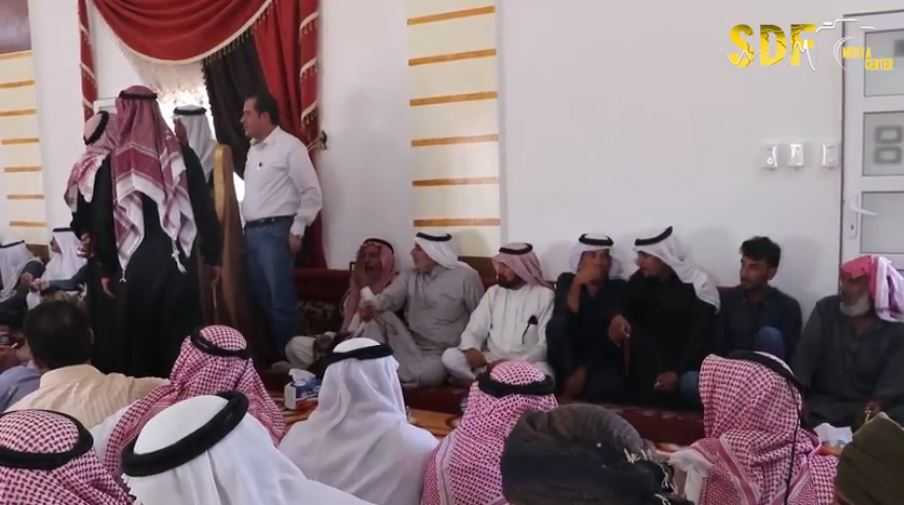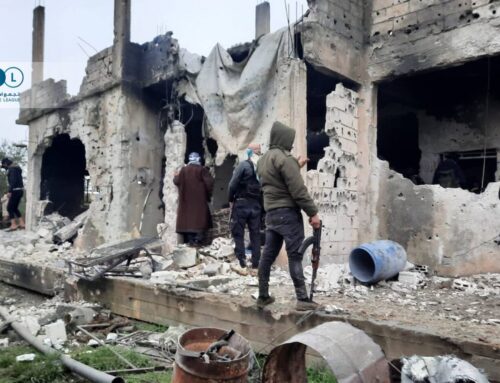With the Islamic State almost entirely pushed out of Deir e-Zor, how can eastern Syria’s tribes pick up the pieces?
SDF commanders meet with Deir e-Zor tribal leaders on August […]
22 August 2018

In the deserts of eastern Syria’s Deir e-Zor province, the Islamic State (IS) has been almost entirely eradicated from the sleepy, rural towns it once controlled along the Euphrates River.
After two massive military offensives last year—one by the Syrian government and its allies, and another by the US-backed, majority-Kurdish Syrian Democratic Forces (SDF) and US-led international coalition—what remains of IS’ Syrian “caliphate” is a patch of empty desert and a handful of embattled villages near the Iraqi border.
But while the colors on Deir e-Zor’s battle map have changed drastically since the group’s near-total defeat, the hardline Islamist group has left behind deep social impacts that will likely outlast it for years to come.
IS divided and conquered local tribes for years, allying with some while brutally massacring others. Today the area’s tribesmen are left to grapple with the aftermath of the group’s control. For some, that means growing numbers of reprisal murders and intra-familial clashes as local clans seek revenge for rights abuses committed under IS.
Tribal violence runs the risk of destabilizing eastern Syria for years to come, even as the frontlines there die down, says Dr. Haian Dukhan, a researcher on Syrian tribes who holds a PhD from the Centre for Syria Studies at the University of St. Andrews in Scotland.
“The fear when IS collapsed was that there would be no ruling authorities in Deir e-Zor,” Dukhan tells Syria Direct’s Madeline Edwards. “The absence of state authority could lead to tribal feuds.”
Dukhan spoke with Syria Direct last year, before the fall of IS in Deir e-Zor, about those fears of continued tribal violence even after the group’s defeat.
Today, he has another concern: that the traditional mode of justice in the province’s tribal system simply has no precedent for the sheer amount of blood spilled there over the past several years of war.
“When you consider the large-scale massacres that happened during the war,” says Dukhan, “I’m afraid that [traditional tribal justice] is going to be dealing with situations it has never dealt with before.”
[Ed:. Click here to read Syria Direct’s full report on the rise of tribal clashes and revenge killings in post-Islamic State Deir e-Zor.]
Q: Last time we spoke, you said one of your main concerns was the likelihood of intra-tribal disputes after IS withdrew from Deir e-Zor, as a sort of settling of accounts between tribes.
Now that IS is gone from most of Deir e-Zor, are we seeing any of those fears play out?
The fear when IS collapsed was that there would be no ruling authorities in Deir e-Zor or in the tribal regions, and that the absence of state authority could lead to tribal feuds.
We are already witnessing to a certain extent some assassinations, some small-scale attacks between families in Deir e-Zor, which hasn’t escalated to a larger scale. Of course, there have been a lot of family disagreements during the civil war over the past few years where particular families have decided to [enact retributions].
During the uprising that turned into a civil war, the tribes have fragmented into competing clans and the clans have been fragmented [within themselves] as well, and there are a lot of small disputes and disagreements at the family level. But if the [governing] authorities in Deir e-Zor collapse, then we could witness larger-scale clashes happening there.
But these revenges could also come to the surface in the absence of any ruling authority in Deir e-Zor in the future.
Q: What needs to start happening now to stop these types of retribution?
We have to remember that there are some people who still sympathize with IS in Deir e-Zor, Raqqa and many of the eastern parts of the country, and that these people could act as sleeper cells in the long-run, to enable IS to rise again in the eastern part of Syria.
That’s why part of the question about what could be done to reach stability in the eastern part of Syria—apart from al-Arf, the tribal law—or a military campaign on the ground, you’d need to have some sort of ideological campaign as well.
There needs to be some sort of organization operating, whether in regime-controlled areas or in SDF areas, that tries to [reverse] the brainwashing that a lot of youth have been exposed to for many years, and that convinces them that what they believed in for a long time does not actually really represent the true image of Islam.
Q: You mentioned previously that IS was successful in spreading its religious ideology in Deir e-Zor. To what extent? Do we still see evidence of this today?
We have to admit that, to a large extent, IS used force and other means to recruit members of the tribes to believe in it, or follow it or fight alongside it.
When I talk about the people who have been brainwashed, I’m talking about a small minority who [nevertheless] still exist in the community, who could actually in the long-run probably enable IS to rise again.
But a large number of the tribes sided with IS based on pragmatic reasons—probably trying to avoid a fate similar to what the Shaitat clan faced in Deir e-Zor.
[Ed.: In August 2014, IS brutally suppressed a failed uprising by the Shaitat clan in a small village southeast of Deir e-Zor city. To make an example of the uprising, IS marched more than 700 young Shaitat men into the desert where fighters filmed themselves decapitating and shooting the tribesmen. The killing of the Shaitat tribesmen remains one of the largest documented mass killings committed by IS throughout its bloody history.]If we want to achieve long-term stability, then having an ideological war as well is very important—probably as important as the military campaign against IS [itself].
Another [consideration] is that in order to achieve some kind of political stability, you would need to improve the economic situation, and create opportunities for these underdeveloped areas that revolted against the regime in 2011 for economic reasons. [Before the war, they were] hit by drought and affected by the regime removing subsidies on agriculture and fodder products for their livestock. The economic status hasn’t improved, and could make these communities open to revolt against the regime [again].
Q: What about in the short term? You mentioned earlier that al-Arf, or traditional tribal law, could be one way to restore the peace in rural Deir e-Zor. How could this work? Can it fill any sort of void, especially now that the SDF seems to be keeping its distance from tribal disputes?
Al-Arf is a traditional tribal law that has been inherited, passed from one generation to another throughout history. Tribal leaders or elders have some sort of council where they meet and try to discuss any disputes arising between their tribe and any other tribe, and try to see if there is any [precedent] from their traditions that could solve the problem.
Even before the war started, if there had been, for example, an honor crime, then al-Arf was usually the most dominant factor in solving such a crime.
But consider what happened to the Shaitat clan in 2014. It was a form of genocide, where you had IS coming and killing more than 700 people all from one village, and then displacing the rest of the clan’s members to outside IS-controlled areas.
I’m not sure if there is anything in al-Arf that could solve such a problem.
Q: That’s because there’s no real precedent in the al-Arf tradition—there’s nothing from the past or from traditional knowledge to compare to the level of carnage we’ve seen over the course of the war.
Exactly, yes. I think al-Arf is going to play a role, but a limited one. When you consider the large-scale massacres that happened during the war, I’m afraid that al-Arf is going to be dealing with situations it has never dealt with before.
So al-Arf on its own might not be enough to solve all these problems.
Q: So what should SDF governance look like now, in rural Deir e-Zor, if al-Arf isn’t enough to solve these crimes carried out under IS as well as wartime intra-tribal disputes? Should we expect to see the SDF getting more involved in this?
They should, but it has to be done in a subtle way. Maybe they would need to hold meetings with the tribal leaders. The SDF is sometimes viewed as a Kurdish-dominated force and therefore the SDF does not need to get involved directly in domestic issues, because that might give the impression to the local residents that they are an occupying force. They could organize tribal conferences at a larger scale in Deir e-Zor, for example. This is one way.
I guess another, informal way, [could be] to co-opt a large number of the tribes by employing them in the military services, or other public services that would be operating in Deir e-Zor.
Q: More broadly, why should we pay attention to tribal stability in eastern Syria? What’s at stake?
First, tribal disputes or tribal instability could allow groups like IS to appear again in that part of the country, because IS has always played on the differences between these tribes and used the tactic of divide and rule in order to control these populations.
Second, this is an important part of Syria that controls large oil and gas resources, and if the regime or the SDF want to use these resources in order to rebuild the infrastructure, then they cannot do that without involvement from the local communities that inhabit these regions.
This interview is part of Syria’s month-long coverage of former Islamic State-held territories in partnership with the Konrad Adenauer Foundation and reporters on the ground in Syria. Read our primer here.









